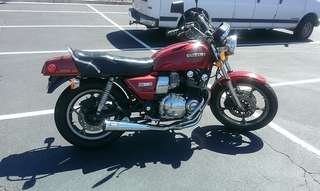This was prompted by these other recent threads and the trials people have been making using the ADVMonster.
This is the link to the Cyclops 3800. It is designed for ON Road use; what I just ordered for my GS1100ED.There is a 10% discount if you enter the "ADV" promotion code.
There is older 3600 which has an Off road pattern. FirstTimer posted about these and brought them to my attentions and claims they are a huge improvement (over a crappy dual sport light). The 3800 has a true "dip" whereas the 3600 just goes from bright to brighter. Dip refers to an angular change in the beam when shifting between Lo and Hi.
I just got off the phone with Sales at cyclopseadventuresports.com and they stated that the LED's generally work well with the typical parabolic reflector (think radar antenna) that our older UJM's have. I will have to do some testing once I get mine; (just ordered). While these apparently work very well, with some fine tuning of the precise locations (using 0.015"-0.080" spacers or O-rings) of the bulb depth into the reflector, the beam pattern can be further modified to improve the horizontal cut off(what keeps the lights out of oncoming drives eyes and what is so important for DOT certification).
In order to know what you are getting, I'll provide a brief description of the principal things to look out for.
There are a lot of these LED bulbs on the market right now, the latest ones use what is called the XML-2 Cree LED emitter. This LED is about 20% brighter than a similarly packages XML cree LED from the last couple of years. So unless it says CREE XML2 it probably is not one. With the CREE XML2 it is now possible to achieve 55W HID light levels with lower cooler temperatures and lower power in a standard H4 installation. This is really the breakthrough event that has spurred me to shell out for a $60 bulb.
The next thing to look for is the number of XML-2 emitters there are. The older style LED bulbs would only have 2 emitters at about 10 watts per for a 20 watt total. The newer XML-2 produce more light at what is also basically about the same 10 watts per bulb. Cyclops use a 13V baseline so 10 watts /13V=.77 amps per bulb. Most of the latest bulbs have 3 XML-2 emitters for as much as 30 watts when on HI. LO is generally running the same LED's at a lower power. Luminance (light output) goes up as more current is run through the emitters. The typical is nominally about 1 amp per emitter but the are rated at up to 3 amps, however no product on the market runs that high. It generates too much heat and the efficiency is actually less (conversion of amps to luminance). The Cyclops 3800 seems to have the largest number of XML emitters (total of 4 ) of any other H-4 bulb replacement on the market (40Watts and 3.0 amps in HI and 20Watts 1.5 amps in LO).
The next thing to realize when comparing bulbs, is that the LED type bulbs while running cooler are essentially a piece of electronics and must be kept much cooler than a burning piece of metal in an evacuated glass bulb. (i.e. Halogen and HID). As such, large heatsinks are necessary at 20 Watts, and fans become standard equipment once get to 30 watt level. At 40watts you need a smart LED driver (sometimes referred to incorrectly as a "ballast"). These are really current controllers. They can sense the amount of current in the LEDs and maintain the level as required. If there is too much current and therefore to much heat the controllers can backoff on the commanded current. This is basically what the Cyclops does if for example there was a fan issue.
While nothing lasts forever, especially a fan, I was assured that these Cyclops fans were of the highest quality with ceramic bearings, and you should absolutely not spray anything in to them like WD40 or the like.
I think in evaluating your purchase you need to understand that you "pay for what you get", the main challenge is to understand "what you are trying to get". Hopefully the discussion above helps in that regard.
Size is a primary concern so first off I want to list the dimensions for the Cyclopse 3800. Apparently this 3800 is slightly smaller than the AVDMonster rev 2.
_______________________________________AVDMonster_ __________Cyclopse 3800
Axial length of heat sink (from H-4 mount)____ 1 11/16"______________1.5"(38mm)
Diameter of heatsink_______________________1 13/16"______________1.65"(42mm)
Thank you Grand Rouge for the measurements who can verify that the AVDMonster will fit inside of the 8" Trainlight back shell (the piece of metal that the reflector is mounted inside of). That being the case it looks like the Cyclopse 3800 with somewhat smaller dimensions will fit as well.
______________________________________Cyclops 3800 in H4/H7
The Cyclopse 3800 LED drive is quite small. The basic dimensions excluding the harness/connector are 1.1"x1.6"x0.5" (WxLxH). I'm hoping to mount this inside of the headlamp back shell (bucket) as well.
.png)
.png)











 . You will burn out you stator even quicker.
. You will burn out you stator even quicker.







 and 77 GS750 with 850 top end, GS850g, and my eldest sons 78 GS550, youngest sons GS125. Project bike 79 GS1000N
and 77 GS750 with 850 top end, GS850g, and my eldest sons 78 GS550, youngest sons GS125. Project bike 79 GS1000N






Comment